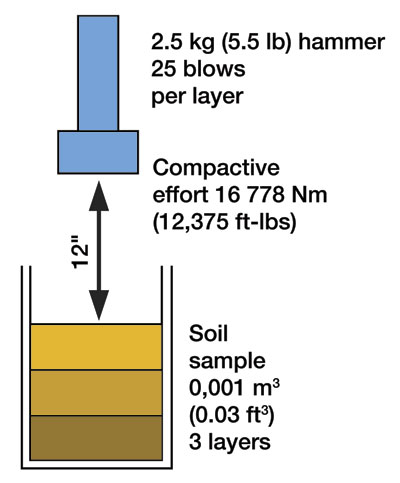Concept
Description and Procedure
The standard oedometer test is carried out on a cylindrical specimen of saturated soil with the dimension of usually 75 mm diamater and 14-20 mm thick. The soil sample is enclosed in a metal ring and is placed on a porous stone. The loading cap has also a porous stone, so the sample is sandwiched between two porous stones. When preparing the sample, filter papers are added between the soil and the porous stones. The sample is then mounted in the consolidation cell and the loading unit. Water is added into the cell around the sample, so the sample remains saturated during the test. The two porous stones at the top and bottom of the sample allow a two-way drainage of the sample.
The test involves applying increments of vertical static load to the sample and recording the corresponding settement. Increments of vertical static load are usually applied using dead loads and a static loading system. The change in the thickness of the sample against time is recorded during each loading increment. The duration of the application of each load depends on the soil ans its consolidation characteristics. Once equilibrium reached for a loading step, the next incremendt is applied. The load is doubled at each increment until reaching the maximum required load, e.g. 25, 50, 100, 200, 400, 800 kPa. The range of applied stress depends on the range of effective stress which is needed in the consolidation analysis of the case under consideration.
When the full consolidation at the maximum applied load is rechaed, the sample is unloaded in one or several stages and the swelling of the sample is recorded. At the end of the test, the sample is carefull yremoved and its thickness and water content is measured.
The consolidation test results include the presentationo of stress-void ratio in a semi-logarithmic scale. From the changes in thickness at the end of each loading step, one can determine the Swelling Index (Cs), Compression Index (Cc) and, Coefficient of Volume Compressibility (mv). The coefficient of consolidation (cv) and the rate of consolidation can be also measured using the results of the thickness changes of the sample against time during a load step.


Standards
- ASTM D698 - 12 Standard Test Methods for Laboratory Compaction Characteristics of Soil Using Standard Effort (12 400 ft-lbf/ft3 (600 kN-m/m3)) Link
- ASTM D1557 - 12 Standard Test Methods for Laboratory Compaction Characteristics of Soil Using Modified Effort (56,000 ft-lbf/ft3 (2,700 kN-m/m3)) Link
References - External Links
NA
